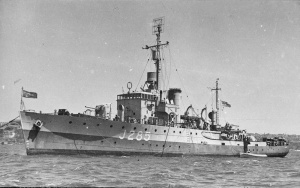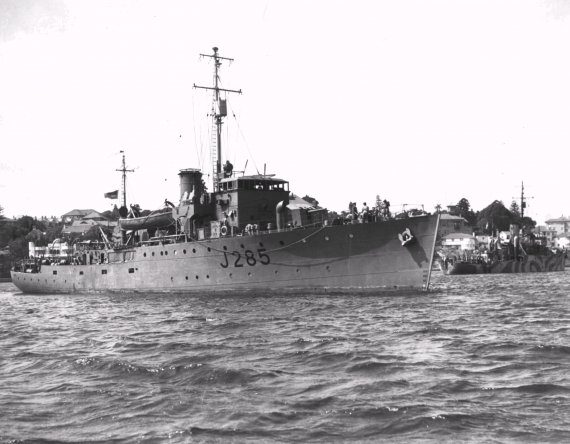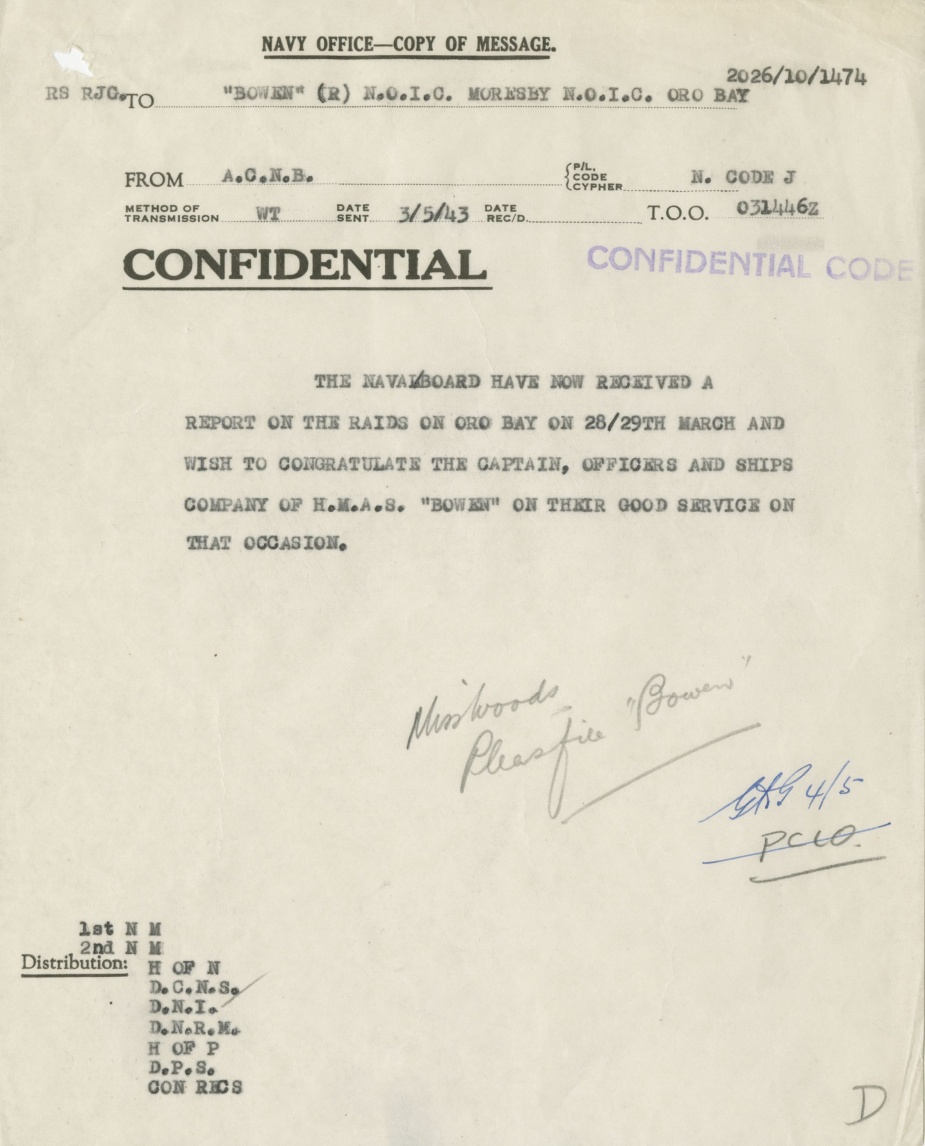HMAS Bowen
| Class |
Bathurst Class |
|---|---|
| Type |
Australian Minesweeper |
| Role |
|
| Pennant |
J285, M285 |
| Builder |
Walkers Ltd, Maryborough |
| Laid Down |
9 February 1942 |
| Launched |
28 July 1942 |
| Launched by |
Mrs G Crittall, wife of a long time employee of Walkers Ltd |
| Commissioned |
9 November 1942 |
| Decommissioned |
17 January 1946 |
| Fate |
Sold for scrap on 18 May 1956 |
| Dimensions & Displacement | |
| Displacement |
|
| Length | 56.69 metres |
| Beam | 9.45 metres |
| Draught | 2.59 metres |
| Performance | |
| Speed | 15 knots |
| Complement | |
| Crew | 85 |
| Propulsion | |
| Machinery | Triple expansion engine, 2 shafts |
| Horsepower | 2000 |
| Armament | |
| Guns |
|
| Other Armament | 40 depth charges, chutes and throwers |
| Awards | |
| Battle Honours | |

HMAS Bowen was one of sixty Australian Minesweepers (commonly known as corvettes) built during World War II in Australian shipyards as part of the Commonwealth Government's wartime shipbuilding programme. Twenty were built on Admiralty order but manned and commissioned by the Royal Australian Navy. Thirty six (including Bowen) were built for the Royal Australian Navy and four for the Royal Indian Navy.
HMAS Bowen was laid down at Walkers Ltd, Maryborough, Queensland on 9 February 1942. She was launched on 28 July 1942 by Mrs G Crittall, wife of a long time employee of Walkers Ltd and was the first RAN warship to carry the name of the coastal town in the Whitsunday region on the eastern coast of Queensland.
Bowen was commissioned at Brisbane on 9 November 1942 under the command of Lieutenant Gordon L Olsen RANR.
Bowen began her active wartime career with convoy escort duty on the east coast of Australia and to the New Guinea forward areas. On 28 March 1942 at Oro Bay, a series of dive bombing attacks ended in the destruction of the Dutch ship Bantam (3014 tonnes) and the American tender Masaya (1065 tonnes), the former having been escorted into the bay by Bowen two days previously. The corvette fortunately escaped the bombing but was strafed by two planes after they had released their bombs on Bantam. After taking off survivors Bowen successfully beached the burning Dutch ship away from the wharf. A stoker in Bowen suffered shrapnel wounds. There were no casualties on board the Bantam but the American ship suffered six killed and several wounded.
Convoy escort and anti-submarine patrols in the north eastern area continued throughout 1943. Bowen's usual employment was on the Cairns-Townsville-Port Moresby-Milne Bay run, interspersed with an odd run into Oro Bay or Buna. They were mostly monotonous, but essential patrols providing protection from submarines for the never ending movement of supplies to the forward areas.
In 1944 Bowen continued operating in the New Guinea area, escorting and patrolling further north as the war progressed, to Madang, Langemak, Saidor, Merauke and the Admiralties. On 15 January, en route to Milne Bay, she rescued two survivors from a RAAF Beaufort bomber which had crashed into the sea. In April, en route to Hyane Harbour, Admiralty Islands, she rescued the only survivor of a crashed United States plane.
In June 1944 Bowen began a period of duty operating between Darwin and Thursday Island, ending in November when she arrived at Melbourne for refitting.
After four months in Australian waters, Bowen returned to New Guinea on escort duties, arriving at Lae in the middle of March 1945, and thence escorting shipping to Madang, Hollandia, Morotai and Biak. In July and August she visited Darwin and was in that port when hostilities ended.
In the immediate post war period she played her part with other units of the RAN in surrender and occupation operations in the Moluccas, before returning to Australia in December 1945.
After visiting Bowen in Queensland for a three day stay, she proceeded to Melbourne where she paid off on 17 January 1946, having steamed 95,651 miles on active service. Bowen was sold on 18 May 1956 to Hong Kong Rolling Mills, Hong Kong, to be broken up.
Note: This video is hosted on YouTube. Department of Defence users will not be able to view this video on the Defence Protected Network.
This cine film has been placed online as part of the Sea Power Centre - Australia’s ongoing archival digitisation program.
Further reading
- Notable Service to the Empire: Australian Corvettes and the British Pacific Fleet, 1944-45, by Hugh Campbell - published by Naval Historical Society of Australia Inc, Garden Island, 1995.
- The Corvettes: Forgotten Ships of the Royal Australian Navy, by Iris Nesdale - published by the author, October, 1982.
- Corvettes - Little Ships for Big Men, by Frank B Walker - published by Kingfisher Press, NSW, 1996.
- The Australian Centenary History of Defence Volume III, The Royal Australian Navy, edited by David Stevens, Oxford University Press, South Melbourne, Victoria, Australia, 2001.









